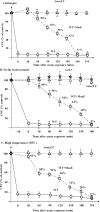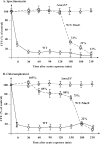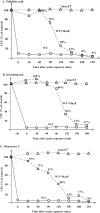Induction of Escherichia coli chromosomal mazEF by stressful conditions causes an irreversible loss of viability - PubMed (original) (raw)
Induction of Escherichia coli chromosomal mazEF by stressful conditions causes an irreversible loss of viability
Ilana Kolodkin-Gal et al. J Bacteriol. 2006 May.
Erratum in
- Correction for Kolodkin-Gal and Engelberg-Kulka, "Induction of Escherichia coli Chromosomal mazEF by Stressful Conditions Causes an Irreversible Loss of Viability".
Kolodkin-Gal I, Engelberg-Kulka H. Kolodkin-Gal I, et al. J Bacteriol. 2023 Dec 19;205(12):e0025723. doi: 10.1128/jb.00257-23. Epub 2023 Nov 15. J Bacteriol. 2023. PMID: 37966211 Free PMC article. No abstract available.
Abstract
mazEF is a stress-induced toxin-antitoxin module located on the chromosomes of many bacteria. Here we induced Escherichia coli chromosomal mazEF by various stressful conditions. We found an irreversible loss of viability, which is the basic characteristic of cell death. These results further support our previous conclusion that E. coli mazEF mediation of cell death is not a passive process, but an active and genetically "programmed" death response.
Figures
FIG. 1.
A point of no return after the induction of the E. coli chromosomal-mazEF_-mediated cell death by inhibition of translation (group 1). Bacterial cultures of E. coli strains MC4100 relA+/pQE-Δ_his_-mazE, MC4100 relA1 (the strain was used for the induction of stressful conditions with serine hydroxamate), and MC4100 relA+ Δ_mazEF were grown to mid-logarithmic phase. (A) Rifampin (20 μg/ml) was added, the cells were incubated at 37°C for 10 min, and then rifampin was removed. (B) Serine hydroxamate (0.1 mg/ml) was added, the cells were incubated at 37°C for 1 h and then serine hydroxamate was removed. (C) Cells were incubated for 10 min in 50°C without shaking. For the rest of the experiment, see the text. The results describe the average of three independent experiments that were carried out in triplicate. Error bars indicate standard deviations. WT, wild type.
FIG. 2.
A point of no return after the induction of the E. coli chromosomal-mazEF_-mediated cell death by inhibition of translation (group 2). Bacterial cultures of E. coli strains MC4100 relA+/pQE-Δ_his_-mazE and MC4100 relA+ Δ_mazEF were grown as described in the legend of Fig. 1. Agents causing the inhibition of translation were added and then removed after incubation without shaking at 37°C for 10 min. (A) Spectinomycin (0.2 mg/ml). (B) Chloramphenicol (0.04 mg/ml). For the rest of the experiment, see the text. The results describe the average of three independent experiments that were carried out in triplicate. Error bars indicate standard deviations. WT, wild type.
FIG. 3.
A point of no return after the induction of the E. coli chromosomal-mazEF_-mediated cell death by DNA damage (group 3). Bacterial cultures of E. coli strains MC4100_relA+/pQE-Δ_his_-mazE and MC410_0 relA_+ Δ_mazEF_ were grown as described in the legend of Fig. 1. (A) Nalidixic acid (1 mg/ml) with incubation for 10 min. (B). Trimethoprim (2 μg/ml) with incubation for 1 h. (C) Mitomycin C (0.25 μg/ml) with incubation for 10 min. For the rest of the experiment, see the text. The results describe the average of three independent experiments that were carried out in triplicate. Error bars indicate standard deviations. WT, wild type.
Similar articles
- Escherichia coli mazEF-mediated cell death is triggered by various stressful conditions.
Hazan R, Sat B, Engelberg-Kulka H. Hazan R, et al. J Bacteriol. 2004 Jun;186(11):3663-9. doi: 10.1128/JB.186.11.3663-3669.2004. J Bacteriol. 2004. PMID: 15150257 Free PMC article. - mazEF: a chromosomal toxin-antitoxin module that triggers programmed cell death in bacteria.
Engelberg-Kulka H, Hazan R, Amitai S. Engelberg-Kulka H, et al. J Cell Sci. 2005 Oct 1;118(Pt 19):4327-32. doi: 10.1242/jcs.02619. J Cell Sci. 2005. PMID: 16179604 - A linear pentapeptide is a quorum-sensing factor required for mazEF-mediated cell death in Escherichia coli.
Kolodkin-Gal I, Hazan R, Gaathon A, Carmeli S, Engelberg-Kulka H. Kolodkin-Gal I, et al. Science. 2007 Oct 26;318(5850):652-5. doi: 10.1126/science.1147248. Science. 2007. PMID: 17962566 - mazEF-mediated programmed cell death in bacteria: "what is this?".
Ramisetty BC, Natarajan B, Santhosh RS. Ramisetty BC, et al. Crit Rev Microbiol. 2015 Feb;41(1):89-100. doi: 10.3109/1040841X.2013.804030. Epub 2013 Jun 25. Crit Rev Microbiol. 2015. PMID: 23799870 Review. - Quorum sensing peptides mediating interspecies bacterial cell death as a novel class of antimicrobial agents.
Kumar S, Engelberg-Kulka H. Kumar S, et al. Curr Opin Microbiol. 2014 Oct;21:22-7. doi: 10.1016/j.mib.2014.09.001. Epub 2014 Sep 20. Curr Opin Microbiol. 2014. PMID: 25244032 Review.
Cited by
- Toxin-antitoxin systems are ubiquitous and plasmid-encoded in vancomycin-resistant enterococci.
Moritz EM, Hergenrother PJ. Moritz EM, et al. Proc Natl Acad Sci U S A. 2007 Jan 2;104(1):311-6. doi: 10.1073/pnas.0601168104. Epub 2006 Dec 26. Proc Natl Acad Sci U S A. 2007. PMID: 17190821 Free PMC article. - The Yersinia pestis chromosome encodes active addiction toxins.
Goulard C, Langrand S, Carniel E, Chauvaux S. Goulard C, et al. J Bacteriol. 2010 Jul;192(14):3669-77. doi: 10.1128/JB.00336-10. Epub 2010 May 14. J Bacteriol. 2010. PMID: 20472800 Free PMC article. - MazF-induced growth inhibition and persister generation in Escherichia coli.
Tripathi A, Dewan PC, Siddique SA, Varadarajan R. Tripathi A, et al. J Biol Chem. 2014 Feb 14;289(7):4191-205. doi: 10.1074/jbc.M113.510511. Epub 2013 Dec 27. J Biol Chem. 2014. PMID: 24375411 Free PMC article. - Hypothetical functions of toxin-antitoxin systems.
Magnuson RD. Magnuson RD. J Bacteriol. 2007 Sep;189(17):6089-92. doi: 10.1128/JB.00958-07. Epub 2007 Jul 6. J Bacteriol. 2007. PMID: 17616596 Free PMC article. No abstract available. - Towards Exploring Toxin-Antitoxin Systems in Geobacillus: A Screen for Type II Toxin-Antitoxin System Families in a Thermophilic Genus.
Alkhalili RN, Wallenius J, Canbäck B. Alkhalili RN, et al. Int J Mol Sci. 2019 Nov 22;20(23):5869. doi: 10.3390/ijms20235869. Int J Mol Sci. 2019. PMID: 31771094 Free PMC article.
References
- Ahmad, S. I., S. H. Kirk, and A. Eisenstark. 1998. Thymine metabolism and thymineless death in prokaryotes and eukaryotes. Annu. Rev. Microbiol. 52:591-625. - PubMed
- Bizanek, R., B. F. McGuinness, K. Nakanishi, and M. Tomasz. 1992. Isolation and structure of an intra-strand cross-link adduct of mitomycin C and DNA. Biochemistry 31:3084-3091. - PubMed
Publication types
MeSH terms
Substances
LinkOut - more resources
Full Text Sources
Molecular Biology Databases


